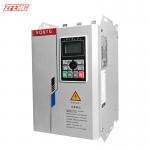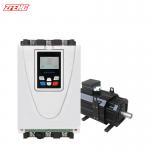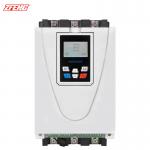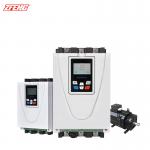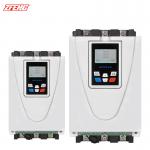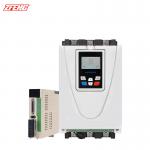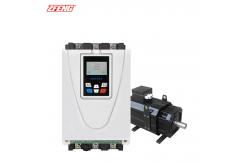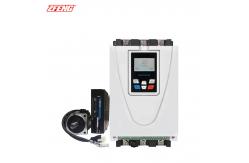ZF-R Series Standard Motor Soft StarterA standard soft starter is a widely used device in the field of motor control. It
achieves smooth starting of motors by controlling the starting
voltage and current, reducing mechanical and electrical shocks
during the starting process, thereby extending equipment lifespan
and improving system reliability.
I. Working Principle of Standard Soft StarterStandard soft starters typically use thyristors (SCRs) or
solid-state relays (SSRs) as power devices. By adjusting the
conduction angle of the thyristors, the output voltage is
controlled, enabling the regulation of the motor starting process.
The working process generally includes the following stages: - Voltage Ramp Start: At the beginning of startup, the soft starter gradually increases
the output voltage at a preset ramp rate, allowing the motor speed
to rise slowly and avoiding excessive starting current.
- Current-Limited Start: During startup, the soft starter can limit the maximum starting
current to prevent it from exceeding the capacity of the motor or
the power grid.
- Full-Voltage Operation: Once the motor reaches its rated speed, the soft starter switches
the output voltage to full voltage, and the motor enters normal
operation mode.
- Soft Stop (Optional): During stopping, the soft starter can gradually reduce the output
voltage, allowing the motor speed to decrease slowly and reducing
mechanical shock.
II. Features of Standard Soft Starter- Smooth Start: By using voltage ramp or current-limited start, it avoids current
surges during motor startup, reducing damage to the power grid and
equipment.
- Protection Functions: Built-in overload protection, short-circuit protection,
under-voltage protection, over-voltage protection, etc., ensuring
the safe operation of the motor and soft starter.
- Adjustable Parameters: Users can adjust startup time, startup voltage, current limit
value, and other parameters according to actual needs to optimize
the startup process.
- Easy Installation and Maintenance: Standard soft starters usually adopt a modular design, making
installation convenient and maintenance simple.
- Strong Compatibility: Suitable for various types of three-phase asynchronous motors,
widely used in fans, pumps, compressors, conveyors, and other
loads.
III. Application Scenarios of Standard Soft Starter- Fans and Pumps: During the startup of fans and pumps, soft starters can reduce
water hammer effects and mechanical shocks, extending equipment
lifespan.
- Compressors: For heavy-duty equipment like compressors, soft starters can
lower starting current, reducing the impact on the power grid.
- Conveyors: During the startup of conveyors, soft starters can prevent
material slippage or equipment damage.
- Other Industrial Equipment: Such as crushers, mixers, grinders, etc., soft starters can
improve the starting performance and reliability of the equipment.
IV. Selection Points for Standard Soft Starter- Motor Power: Choose a suitable soft starter model based on the motor's rated
power, ensuring that the soft starter's rated current is greater
than the motor's rated current.
- Load Type: Select the appropriate starting method (such as voltage ramp
start, current-limited start) based on the load type (e.g., fan,
pump, compressor).
- Grid Conditions: Consider the grid's voltage, frequency, and capacity, and choose
a suitable soft starter to avoid excessive impact on the grid.
- Environmental Conditions: Choose a soft starter with the appropriate protection level
according to the installation environment (such as temperature,
humidity, altitude).
- Functional Requirements: Select a soft starter with the necessary functions based on
actual needs, such as whether soft stopping, communication
functions, or display functions are required.
V. Installation and Commissioning of Standard Soft Starter- Installation:
- Ensure that the soft starter is installed in a well-ventilated
location, avoiding direct sunlight and humid environments.
- Connect the power lines, motor lines, and control lines correctly
according to the instructions.
- Ensure proper grounding to prevent electric shock accidents.
- Commissioning:
- Check all wiring for correctness before startup to ensure there are
no short circuits or open circuits.
- Set the startup time, startup voltage, current limit value, and
other parameters according to actual needs.
- Perform a no-load test run to check the soft starter's operating
status and the motor's startup condition.
- Perform a load test run to observe the motor's operating
performance and the soft starter's protection functions.
VI. Maintenance and Care of Standard Soft Starter- Regular Inspection: Regularly check the soft starter's appearance, wiring, and
cooling condition to ensure normal operation.
- Cleaning and Maintenance: Regularly clean the soft starter's cooling fins and fans to
prevent dust buildup from affecting cooling performance.
- Parameter Calibration: Regularly calibrate the soft starter's parameters to ensure
normal startup performance and protection functions.
- Fault Handling: If a soft starter fault is detected, immediately cut off the
power supply and contact a professional for repair.
|
